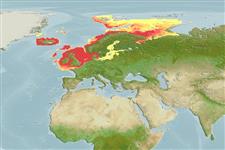Environment: milieu / climate zone / depth range / distribution range
Ecología
marino demersal; rango de profundidad 1 - 300 m (Ref. 35388). Temperate; 81°N - 48°N, 25°W - 62°E
Northeast Atlantic: southern Norway north to Barents Sea including Novaya Zemlya, Spitsbergen and Bear Island, also Iceland.
Tamaño / Peso / Age
Maturity: Lm ? range ? - ? cm
Max length : 15.0 cm TL macho / no sexado; (Ref. 4645)
Short description
Morfología | Morfometría
Suction disc much larger than the eye diameter. Dorsal and anal fins overlap with the caudal fin. Two nostrils on each side of the snout (Ref. 35388).
Occurs from the subtidal zone to less than 300 m (Ref. 4702). Feeds primarily on crustaceans, occasionally fishes and polychaetes (Ref. 4702). Spawns in the winter (Ref. 35388).
Life cycle and mating behavior
Madurez | Reproducción | Puesta | Huevos | Fecundidad | Larva
Perlmutter, A., 1961. Guide to marine fishes. Bramhall House, New York. 431 p. (Ref. 169)
IUCN Red List Status (Ref. 130435)
Threat to humans
Harmless
Human uses
Más información
ReferenciasAcuiculturaPerfil de acuiculturaRazasGenéticaElectrophoresesheritabilidadEnfermedadesProcesamientoNutrientsMass conversion
Herramientas
Special reports
Download XML
Fuentes de Internet
Estimates based on models
Preferred temperature (Ref.
123201): 4.9 - 11.4, mean 8 °C (based on 512 cells).
Phylogenetic diversity index (Ref.
82804): PD
50 = 0.5000 [Uniqueness, from 0.5 = low to 2.0 = high].
Bayesian length-weight: a=0.00525 (0.00237 - 0.01161), b=3.15 (2.96 - 3.34), in cm total length, based on LWR estimates for this (Sub)family-body shape (Ref.
93245).
Nivel trófico (Ref.
69278): 3.6 ±0.58 se; based on food items.
Resiliencia (Ref.
120179): Bajo, población duplicada en un tiempo mínimo de 4.5-14 años (Fecundity assumed < 100).
Fishing Vulnerability (Ref.
59153): Low vulnerability (10 of 100).
